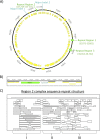Correlation of Host Range Expansion of Therapeutic Bacteriophage Sb-1 with Allele State at a Hypervariable Repeat Locus
- PMID: 31492663
- PMCID: PMC6821964
- DOI: 10.1128/AEM.01209-19
Correlation of Host Range Expansion of Therapeutic Bacteriophage Sb-1 with Allele State at a Hypervariable Repeat Locus
Abstract
Staphylococci are frequent agents of health care-associated infections and include methicillin-resistant Staphylococcus aureus (MRSA), which is resistant to first-line antibiotic treatments. Bacteriophage (phage) therapy is a promising alternative antibacterial option to treat MRSA infections. S. aureus-specific phage Sb-1 has been widely used in Georgia to treat a variety of human S. aureus infections. Sb-1 has a broad host range within S. aureus, including MRSA strains, and its host range can be further expanded by adaptation to previously resistant clinical isolates. The susceptibilities of a panel of 25 genetically diverse clinical MRSA isolates to Sb-1 phage were tested, and the phage had lytic activity against 23 strains (92%). The adapted phage stock (designated Sb-1A) was tested in comparison with the parental phage (designated Sb-1P). Sb-1P had lytic activity against 78/90 strains (87%) in an expanded panel of diverse global S. aureus isolates, while eight additional strains in this panel were susceptible to Sb-1A (lytic against 86/90 strains [96%]). The Sb-1A stock was shown to be a mixed population of phage clones, including approximately 4% expanded host range mutants, designated Sb-1M. In an effort to better understand the genetic basis for this host range expansion, we sequenced the complete genomes of the parental Sb-1P and two Sb-1M mutants. Comparative genomic analysis revealed a hypervariable complex repeat structure in the Sb-1 genome that had a distinct allele that correlated with the host range expansion. This hypervariable region was previously uncharacterized in Twort-like phages and represents a novel putative host range determinant.IMPORTANCE Because of limited therapeutic options, infections caused by methicillin-resistant Staphylococcus aureus represent a serious problem in both civilian and military health care settings. Phages have potential as alternative antibacterial agents that can be used in combination with antibiotic drugs. For decades, phage Sb-1 has been used in former Soviet Union countries for antistaphylococcal treatment in humans. The therapeutic spectrum of activity of Sb-1 can be increased by selecting mutants of the phage with expanded host ranges. In this work, the host range of phage Sb-1 was expanded in the laboratory, and a hypervariable region in its genome was identified with a distinct allele state that correlated with this host range expansion. These results provide a genetic basis for better understanding the mechanisms of phage host range expansion.
Keywords: Staphylococcus aureus; adaptation; bacteriophage adaptation; genome analysis; host range expansion; hypervariable DNA region; phage Sb-1; putative host range determinant; therapeutic bacteriophage.
Figures







References
-
- Centers for Disease Control and Prevention. 2014. Active bacterial core surveillance report: methicillin-resistant Staphylococcus aureus. Centers for Disease Control and Prevention, Atlanta, GA: https://www.cdc.gov/abcs/reports-findings/survreports/mrsa14.html.
-
- National Institute of Allergy and Infectious Diseases. 2014. NIAID’s antibacterial resistance program: current status and future directions. National Institute of Allergy and Infectious Diseases, North Bethesda, MD: https://www.niaid.nih.gov/sites/default/files/arstrategicplan2014.pdf.
Publication types
MeSH terms
LinkOut - more resources
Full Text Sources
Other Literature Sources
Medical

